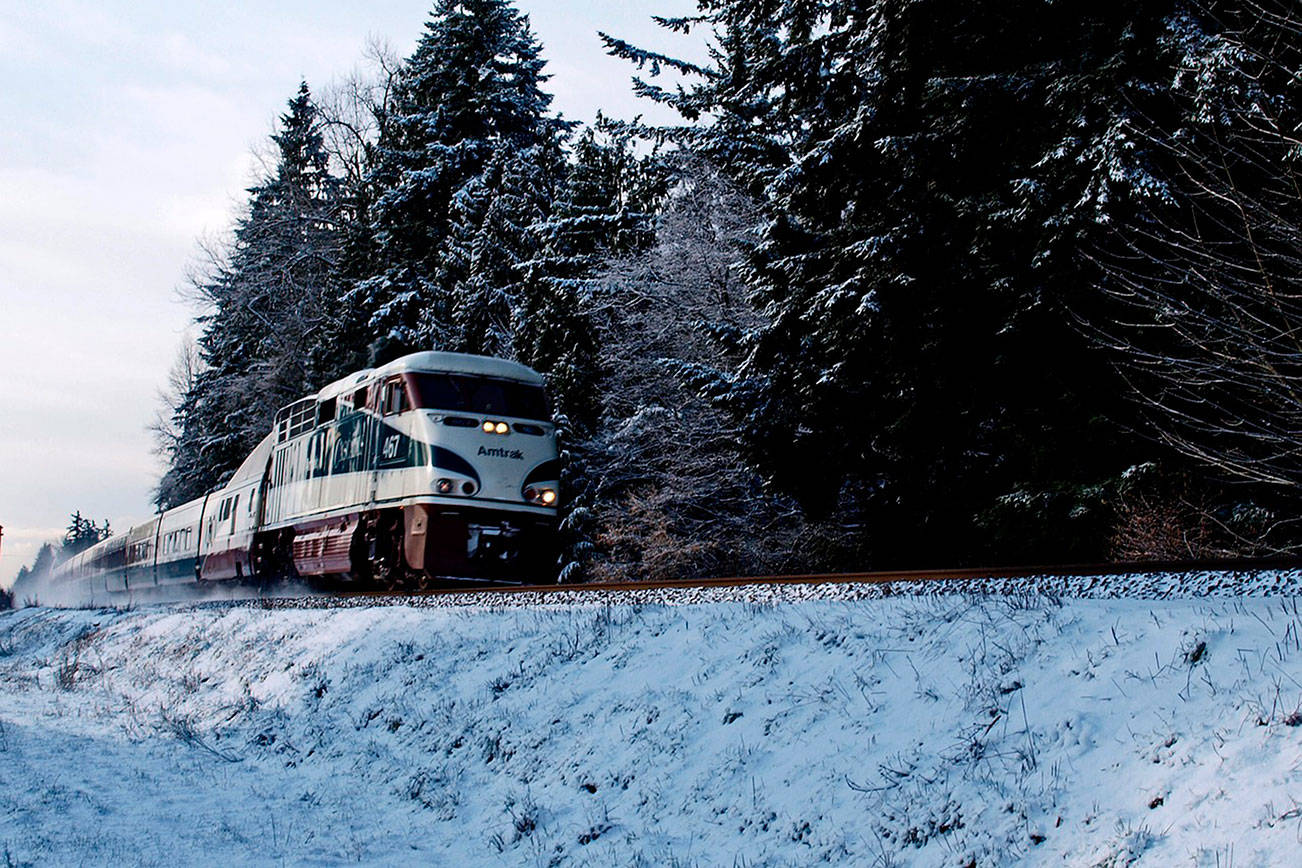From the late 1800s to 1981, passenger trains rumbled their way through Stampede Pass from Puget Sound to destinations in Eastern Washington. Nearly four decades after passenger train service stopped, Washington state is once again eyeing those tracks.
The Washington State Department of Transportation (WSDOT) has been studying the possibility of an ultra-high-speed rail line running from Vancouver, B.C., to Portland, with a stop in Seattle. But making that work would require accessibility — and perhaps another rail link to Eastern Washington. And so the state Legislature started looking at the possibility of reviving a passenger route running from Auburn through Central Washington cities to Spokane.
The idea of expanding Washington’s train system is nothing new for former state Rep. Luis Moscoso, who founded the House’s rail caucus. Now that he’s out of the Legislature, he spends time advocating for All Aboard Washington, which lobbies for more rail transportation in Olympia.
“If we’re going to have a statewide train network as we said we wanted, then it’s long overdue,” Moscoso said of the Stampede Pass line.
The state has looked into restarting passenger travel across the pass for decades, including in 2001, when WSDOT commissioned a study. There were no rail champions in the Legislature at the time, Moscoso said, so the study dropped off the radar. But as the region becomes more congested and lawmakers are more concerned with reducing transportation emissions, lawmakers are looking again to the rail.
Members of the Legislature’s Joint Transportation Committee listened to a presentation from Steer Group, a consultant organization hired by the state to study an east-west corridor over Stampede Pass. The group is working on a $250,000 report, which it will deliver to the Legislature by next June. Rep. Andrew Barkis (R-District 2) was at the meeting and heads the rail caucus.
“We’re getting more and more calls for alternative modes of transportation, both in the sense of getting people out of their cars, but also if you’ve ever driven over to Eastern Washington in winter, it’s a little challenging,” he said.
Currently, traveling across the state means people have to drive or take a bus, fly on expensive intrastate airlines, or spend nearly nine hours riding the Amtrak Empire Builder line north through Leavenworth to Spokane. A southern line of the Empire Builder splits in Spokane and goes south through Pasco before running along the Columbia River.
BNSF, which owns the rail line, runs about six freight trains eastward daily over Stampede Pass. But the tracks could support as many as 39 trains per day. The actual number of passenger train trips would likely only be a handful. Because the line is a single track, it would take coordination with BNSF to ensure trains headed in both directions could pass each other.
But the line wouldn’t just benefit riders in Eastern Washington. A feasibility study of ultra-high-speed trains between B.C. and Portland found that the Auburn-Spokane connection through Central Washington could increase ridership on the north-south line by between 15 and 25 percent.
The riders and more connections would be vital for future north-south high-speed rail, WSDOT communications manager Janet Matkin said. The high-speed rail between B.C. and Portland could carry 32,000 people an hour, which would significantly affect traffic on Interstate 5.
“The important component of the ultra-high-speed systems is the connectivity to other existing modes of transportation, and that would include this east-west route as well as transit systems,” Matkin said.
The ultra-high-speed rail could transport people from B.C. to Seattle in about an hour, and from Seattle to Portland in about the same amount of time. Trains could travel at about 250 mph, marking the country’s first rail system to provide service at those speeds. On top of that, it would serve the Cascadia mega-region, one of 11 that is expected to develop in the U.S. by 2050.
The ultra-high-speed rail stems from the 2016 Cascadia Innovation Corridor Conference where representatives from the Pacific Northwest (including B.C.) and Microsoft discussed developing the region as a commercial hub.
Unlike the proposed $24 billion to $44 billion the ultra-high-speed rail could cost, Moscoso said the Auburn-Spokane connection has one important leg-up — it’s already built.
“There’s all kinds of good reasons why this state asset should be sustained and expanded and utilized for the purpose of transportation for its residents,” he said.
Lloyd Flem, a longtime advocate for rail and member of All Aboard Washington, said there has been interest in restarting the east-west link for at least 15 years. Some of the rail stations are still in good shape too, but the real issues for starting service would be looking at potential ridership, cost and infrastructure improvements, which should be addressed in the Steer Group report.
Additionally, legislators are paying more attention to CO2 emissions now. Trains rolling over Stampede Pass could be electrified, but even conventional fossil fuel trains could provide environmental benefits when compared to automobile or plane travel.
According to the WSDOT 2019 business case study on ultra-high-speed rail, the rail emits between 5 to 12 times less CO2 than air travel, and 3 to 5 times less than automobiles. Electrification of rail can lead to even fewer emissions, provided the energy being used is generated from clean sources.
The study found that trains generate 14 grams of CO2 per passenger per kilometer traveled. That’s lower than the 20 grams generated from high-speed rail, and even the 68 grams generated per passenger by bus. Planes clock in at a whopping 285 grams per passenger per kilometer.
Flem said he thinks those numbers could gain the attention of environmental groups in Puget Sound, which have historically focused on metropolitan rail systems like Sound Transit’s Light Rail.
“We have some educating to do, and reminding them that that’s green and environmentally responsible now too,” Flem said.


